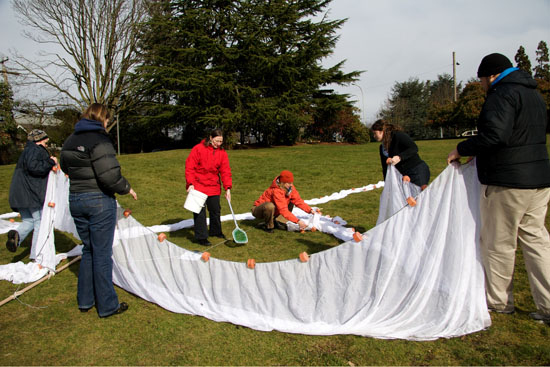NOAA Fisheries Reaches Out to Teachers With Hands-On Learning
Lynne Barre
Northwest Regional Office, NOAA Fisheries
April 22, 2009 — As the pods moved into formation, you could hear the familiar high-pitched squeaks of killer whale calls.
But, these weren’t whales.
They were, in fact, elementary school teachers (armed with noisy little balloons) taking part in a hands-on learning module called “Saving Springer: How NOAA Helped an Orca Go Home,” a curriculum on killer whales developed by the NMFS Alaska Fisheries Science Center.

High school teachers try their hand at beach seining (fishing with weighted vertical nets) as part of a new NOAA teacher training workshop held in Seattle, Wash. Photo credit: Su Kim, NOAA Northwest Fisheries Science Center.
The grade school teachers were part of a group of 30 middle and high school science educators who met in Seattle, Wash., in February to participate in the Marine Education Workshop for K–12 Teachers. Staff from NOAA Fisheries’ Northwest Fisheries Science Center, Alaska Fisheries Science Center, Northwest Regional Office, and Washington Sea Grant personnel teamed up to develop the new workshop.
Teaching the Teachers, and Listening Too
The seminar showcased the comprehensive educational resources NOAA Fisheries staff and partners in the Pacific Northwest have developed for teachers and students throughout the region. The new curricula and classroom activities presented were designed in support of NOAA’s education mission to advance environmental literacy and promote a diverse workforce in ocean sciences.
“A workshop like this is a great way to connect with teachers and keep up on what each of our offices is doing in education,” said Deborah McArthur, the lead workshop organizer from NWFSC.
The workshop format is based on three key objectives to:
- Build a network of teachers familiar with NOAA’s education programs and products.
- Learn what educators need from both NOAA and Sea Grant to enhance their teaching.
- Create a model workshop format that other NOAA offices may use to highlight their educational resources.
What a Difference a Day Makes
The science teachers met in the morning at the Northwest Fisheries Science Center to learn about NOAA, NOAA Fisheries, Washington Sea Grant, and the basic principles of ocean literacy for grades K–12. In the afternoon, they divided into three groups and traveled to the different NOAA facilities for further briefings tailored to their specific grade levels.
Workshop attendees participated in a variety of interactive teaching activities that simulated real-life scenarios, for example:
- Middle school teachers took on the role of stakeholders in a discussion about managing sustainable halibut fisheries. This activity is part of a curriculum developed by the Northwest Regional Office that incorporates science with social studies and civics.
- High school teachers received first-hand training on “Econauts,” a field and classroom-based curriculum developed by the NWFSC, which featured an exercise in beach seining — a method of catching fish using weighted nets hung vertically in the water. They also sorted and identified fish, and used statistics to determine distribution and abundance.
Overall, the workshop received high marks.
“The best part of the program was learning about the connection that can be made between NOAA and schools. I’m excited to use this resource!” one enthusiastic participant said.
The NOAA Fisheries conference team plans to offer another workshop this fall. In the meantime, the organizers will be working with NOAA colleagues in other offices and regions to help them develop their own educator workshops.
